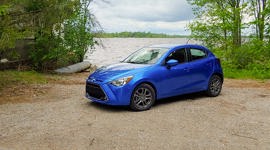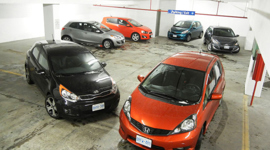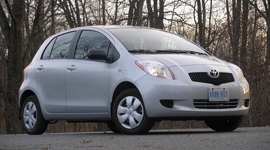 AutoTrader SCORE
AutoTrader SCORE
-
COMFORT6/10
-
PERFORMANCE7/10
-
FUEL ECONOMY8/10
-
INTERIOR8/10
-
EXTERIOR STYLING4/10
The rumour is that as dominant as Walmart is on the big-box retail front (which pretty much makes it dominant on the retail front in general), it knows as well as anyone that there’s always someone out there doing something better. Not on the whole; but in parts. A better Hot Wheels display, for example. Or more-organized clothing racks, better fitting rooms and so on.
The Yaris doesn’t look like that tall of a car. Once inside, however, headroom is ample to the point it makes Toyota’s claimed 970 mm of front headroom seem a little conservative.
So what does Walmart do? Well, it abides by the “if you can’t beat ‘em, join ‘em” adage and it finds a retailer that’s doing something better, and copies it for its stores.
It seems that this logic was not lost on Toyota when it came time to re-designing this particular example of a Small Car for a Big Guy; except, unlike Walmart, they didn’t really do it piecemeal. They went whole hog and pretty much took what w ould have been the latest-gen Mazda2, slapped some Toyota badges on it, and had the new Yaris Sedan. The hatchback remains (and looks) an entirely different animal, which stands to reason as it hails from France as opposed to Mexico like the car you see here.
Indeed, looking at the two cars, I challenge you to find any familial similarities at all; the sedan seems to suffer what many Mazdas did a few years ago, that is to say a front fascia that looks like the vehicular equivalent of Mr. Sardonicus. Other Mazdas have mostly recovered from this, but it seems those that designed the “Toyota2” didn’t get the memo. The rest is OK, if nothing special, but that front end needs a once over, that’s for sure.
The Knee Test
Bit of a mixed bag, this one.
On one hand, it took me a few tries before I finally remembered to watch myself as I stepped into the car, as I must’ve smacked my knee the first five times I stepped into the thing, as the centre console flares out at the base of the centre stack, leaving my poor knee wide open for a thrashing.
However; once I was actually sat in the car, I found the leg room to be just fine, as the centre console tapers towards the floor, allowing more room for splayed knees.
The lack of a big storage bin in the centre console means that it’s a little narrower, allowing room for more “generous” hips and a somewhat airier cockpit. That, combined with the well-padded seats make for a comfortable seating position…for the most part. I did find my left shoulder to be firmly pressed up against the B-pillar when driving, and my right shoulder when sat in the passenger seat.
Headroom, however, is the opposite. Thanks to the rounded roofline, the Yaris doesn’t look like that tall of a car; once inside, however, headroom is ample to the point it makes Toyota’s claimed 970 mm of front headroom seem a little conservative. I couldn’t believe how much room I had when I looked up; you can thank the height-adjustable driver’s seat for the phenomenon. It also makes for easier entrance and egress – while I bumped my knee a few times, my skull never had the same problem. The rear seat figures, on the other hand, seem right on point; Toyota rates it at 934 mm and when I sat back there, well, let’s just say that my hairdo once I got out left very little to the imagination.
Another look: 2016 Toyota Yaris Sedan Test Drive
Rear legroom is rated at 874 mm which is pretty snug, but more than what you get in either the Kia Rio sedan or its cousin, the Hyundai Accent sedan. When sat behind a driver seat set to my 6'3" frame, I still had to be mighty careful when closing the door, lest I cause more damage to my beleaguered knees. There’s no rear armrest, which I guess could be an issue for some. I’d rather have the extra room for hips on the rare occasion I’d be shuttling four adults ’round, though, and a proper bench seat with no encumbrances allows for that.
The Hockey Bag Test
The trunk opening is not huge but at 382 L, if you can finagle your wares through, there’s plenty room once it’s all in there. It’s so deep that you’d think there were no folding rear seats but lo and behold, the rear seats do fold in a 60/40 split. And, once folded, they sit almost completely flat against the seat cushions. Get past that narrow trunk opening, and you should have no trouble loading it with beer.
The Rest
Indeed, there is very little to hide the fact that this is a Mazda once you consider the interior environs. From the steering wheel, to the gauge cluster (that’s mostly good, save for the tough-to-read displays on either side of the speedometer), the climate controls and even the vent roundels, the Mazda-ness is just dripping from this cockpit. I’m honest when I say that more often than not, I actually had to stop and remind myself I was driving a Toyota, and not a Mazda. The pop-up display is yet another dead giveaway; that’s all Mazda. If you need navigation, then a 7-inch, full-colour display comes as standard on the Premium trim; the vehicle you see here is simply called “Yaris Sedan 6AT”, on account of the optional six-speed automatic transmission. The Yaris comes fitted with a six-speed manual as standard.
Which is no bad thing as Mazda continues to build top-quality interiors that permeate throughout the line-up. The materials are great; I love that leather striping between the upper and lower dash in front of the passenger and above the centre stack, as well as the carbon fibre inserts – carbon fibre, in a Yaris! – around the window controls and on the steering wheel spokes.
The ergonomics are there, too, as we discussed in the previous section, and while it is a little dark in here – and indeed, that black interior is your only choice – it seems somehow more grown-up than other vehicles in the segment, such as the aforementioned Hyundai or even the Nissan Sentra, whose manufacturer is also known for crafting some memorable interiors.
I guess the one thing I’d like to have is a storage bin in the centre console; the skinny little cubby is really only good enough for a wallet and maybe a mobile device. There’s another cubby between the two front seats, but I found that to be awkward to get at, even though I had the seat pretty far back (Big Guy, remember). It’s more of a spot for your rear passengers to use. I worry the interior would get a little messy, simply because there’s precious little place to put things.
Let’s hit the road
The Mazda2-to-Yaris relationship isn’t just skin deep, either; the 1.5 L four-banger up front is all Mazda. Indeed, it’s hard to hide that fact when you consider the engine’s tone on start-up; like other Mazda’s that use the brand’s fuel-efficient Skyactiv tech, the engine starts up with a bit of an off-beat warble caused by the fuel-saving accelerated exhaust warming process. It’s a unique sound more akin to a Subaru boxer engine than an old Yaris, and it does take some getting used to.
Once underway, you have 106 hp and 103 lb-ft of torque at your disposal, enough to get the car going in a somewhat sprightly fashion. Yes, the six-speed slushbox is a bit of a downer, but it’s hard to expect too much more from and econobox like this.
Luckily, the Yaris excels at what an econobox is supposed to excel at: moving you through town nimbly and in good comfort. Part of that comfort is thanks to those squishy seats, but the dampers have been tuned to provide a firm but not brittle ride.
The suspension works in concert with the direct steering rack to make for a responsive chassis whose dynamics have “Mazda” written all over them; that is to say a pointable nose that responds quickly to your inputs, exhibiting surprisingly low body roll while it’s at it.
The lightness of the car helps here – at 1,096 kg, it weighs less than a similarly equipped Accent or Fiesta sedan – as well as in the braking department. The Yaris comes with discs up front and drums out back, and while the pedal feel could be a little less wooden, the car responds to panic stops with nary a complaint.
Would I like to see a bit more power? Perhaps, but clunky as it can be, the six-speed transmission does help get the most of the somewhat limited power available. Even the Nissan Micra makes more, but thanks to the extra two gears on the Yaris (the Micra’s optional auto is a four-speed), it doesn’t feel like a less-powerful car necessarily. I will say that I was much more comfortable in the Yaris on the highway than in the Micra.
Of course, another big part of Mazda’s Skyactiv tech is its fuel efficiency, and in that light the Prius didn’t disappoint; after a week of mainly city driving, we saw less than 8.0 L/100 km of fuel usage. That’s a tick off of Toyota’s claimed figures, but I’m not too bothered by that in this case. I’ll take that kind of fuel economy any day of the week.
So if you’re of taller ilk…
Well, you won’t have any problems with either front or rear headroom, that’s for sure. During my entire week with the vehicle, it never ceased to amaze me just how spacious it was in that department. They really got this aspect right.
A little less so when it comes to the legroom issue; as I said before, I never quite got over just how much thinking was required to step into the driver’s seat in order to avoid once again smacking my knee. Worse still, it seems that I managed to hit the exact same spot every time, to the point where the sting would stick around for that much longer.
Learn your way around that, though, and the Yaris remains a properly comfortable car up front, if not so much in the rear for the long-legged among us. Keep the kids in the back – or the rear seats folded – and you’ll be just fine.
I suppose the overriding question, though, is whether you’re good with a subcompact sedan in general. They’re getting fewer and farther between, and Toyota’s option is an appealing one. The Yaris hatch is less expensive than the sedan, and while it’s snugger still out back, it’s a better-looking car (one of the nicer examples Toyota makes, actually), has even more headroom up front, and the convenience of a hatch. You don’t get the Mazda tech – for the time being, anyway – but be sure to give both a try before you buy.
| Warranty: 3 years/60,000 km; 5 years/100,000 km powertrain; 5 years/unlimited distance corrosion perforation; 3 years/60,000 km roadside assistance Competitors: |
| Model Tested | 2016 Toyota Yaris Sedan AT |
|---|---|
| Base Price | $18,200 |
| A/C Tax | $100 |
| Destination Fee | $1,535 |
| Price as Tested | $19,835 |
|
Optional Equipment
None
|
|








































